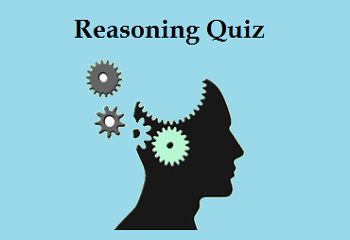Hello Aspirants. Welcome to Online Quantitative Aptitude section in AffairsCloud.com. Here we are creating question sample From all topics , which are Important for upcoming IBPS exams. We have included Some questions that are repeatedly asked in exams.
- A sugar and a water solution of 100 litres consists of 20% of sugar. If the solution is heated, water evaporates and the sugar concentration becomes 80% of the solution. What amount of water has evaporated?
A. 70 litres
B. 50 litres
C. 75 litres
D. 65 litresC. 75 litres
Explanation:
In 100 litres solution, sugar = 20 l, water = 80 l
Suppose x litres of water evaporated.
So now the solution becomes (100-x) litres and water becomes (80-x) litres.
In this (100-x) litres, 20% is water.
So 20/100 (100-x) = 80-x
Solve, x = 75 - Two die are tossed simultaneously. Find the probability that the multiplication of the two numbers on the die is a composite number.
A. 1/6
B. 1/2
C. 5/6
D. 29/36D. 29/36
Explanation:
Maximum product can be 6*6 = 36
Prime numbers = 2, 3, 5, 7, …
But after 5, the pairs for multiplication are not available.
So the required 6 pairs are – {(1,2)(2,1)(1,3)(3,1)(1,5)(5,1)}
With 6 pairs as prime number multiplication, we are left with 36-6 = 30 pairs for composite numbers, by pair (1,1) is neither prime nor composite, so composite pairs are 30-1 = 29
So prob of composite = 29/36 - A and B move towards each other from two towns that are 55 km apart. A’s speed is 12 km/hr and B’s speed is 10 km/hr. After how much time will they be 11 km apart?
A. 1 hr
B. 2 hr
C. 4hr
D. 6 hrB. 2 hr
Explanation:
They have to be 11 km apart, so total distance to be travelled by them is (55-11) = 44 km
Since in opposite direction, so relative speed = 12+10 = 22 km/hr
So time = 44/22 = 2 - 20 men and 30 women take 5 days to complete a piece of work. It takes 20 days for the same work to be completed by 6 men and 5 women. How many days will it take for 40 men to complete the same work?
A. 2
B. 3
C. 4
D. 6C. 4
Explanation:
(20 m + 30 w) × 5 = (6 m + 5 w) × 20
Solve, 1 w = 2/5 m
Therefore, 30 w = 12 m
We have 20 m + 30 w takes 5 days
Or now 20 m + 12 m takes 5 days
32 m takes 5 days, so 40 m takes 32×5 ÷ 40 = 4 - A works twice as fast as B and three times as fast as C. If C can complete a job in 12 hr, then what part of the job can B complete in 1 hr?
A. 1/2
B. 1/4
C. 1/8
D. 1C. 1/8
Explanation:
Time taken by A, B and C is x, 2x, and 3x
3x = 12, x = 4
Time taken by B to complete a work = 8 hr
So part of work in 1 hr = 1/8 - A commodity is sold at 10% profit. If it had been bought at 10% less and sold for Rs 2 less, then the gain% would have been 16 2/3%. Find the cost price.
A. Rs 30
B. Rs 40
C. Rs 25
D. Rs 35B. Rs 40
Explanation:
We have a direct formula for these type of ques:
x = 10% profit, y = 10% loss, z = 16 2/3% new profit, A = Rs 2
(100+x)/100 * CP + A = (100-y)/100 * (100+z)/100 * CP
Here the article is sold for Rs 2 less, so for less we take (-2)
(100+10)/100 * CP + (-2) = (100-10)/100 * (100+(50/3))/100 * CP
Solve, CP = 40 - There are 3 red balls, 4 blue balls, 6 white balls. Three balls are drawn at random. Find the probability that there is at least 2 red ball.
A. 21/286
B. 31/286
C. 16/143
D. 20/143B. 31/286
Case 1 : 2 red balls:
Prob = 3C2 × 10C1 / 13C3 = 15/143.
Case 2 : 3 red balls:
Prob = 3C3 / 13C3 = 1/286.
So total prob. = 15/143 + 1/286= 31/286 - A trader bought 10 kg oranges for Rs 405 of which 1 kg was found rotten. If he wishes to make a profit of 10%, at what rate per kg should he sell the remaining oranges?
A. Rs 48.66
B. Rs 49.50
C. Rs 51.25
D. Rs 44.55B. Rs 49.50
Explanation:
After 1 kg found rotten, CP of 9 kg of oranges becomes Rs 405
For 10% profit, SP of 9 kg = 110/100 * 405 = 445.50
So SP per kg = 445.50 ÷ 9 = 49.50 - In a town of population 1,20,000, 55% were males and rest females. If 48% of males and 60% of females can vote, then what is the total number of voters in the town?
A. 64,320
B. 64,080
C. 70,000
D. 69,890B. 64,080
Explanation:
Males = 55/100 * 1,20,000 = 50/100 of 1,20,000 + 5/100 of 1,20,000 = 60,000 + 6000 = 66,000
Male voters = 48/100 * 66,000 = 50% of 66,000 – 2% of 66,000 = 33,000 – 1320 = 31680
Females = 1,20,000 – 66,000 = 54,000
Female voters = 60/100 * 54,000 = 32400
Total voters = 31680 + 32400 - A man can row 10 km/hr in still water. When the river is running at 4 km/hr, it takes him 5 hrs to row to a place and come back. How far is the place?
A. 20 km
B. 22 km
C. 21 km
D. 35 kmC. 21 km
Explanation:
B is speed of boat in still water, R is speed of stream
Time is total time taken for upstream and downstream
Distance = time * [B^2 – R^2] / 2*B
=5 * [10^2 – 4^2] / 2*10
AffairsCloud Recommends Oliveboard Mock Test
AffairsCloud Ebook - Support Us to Grow
Govt Jobs by Category
Bank Jobs Notification



